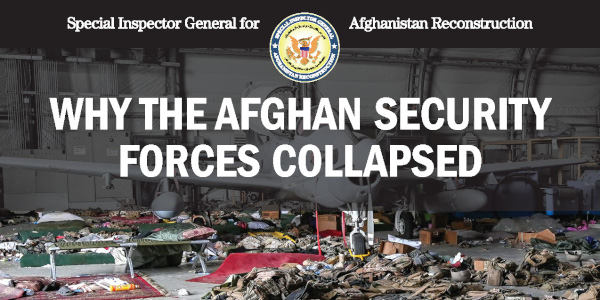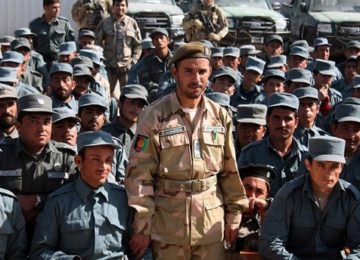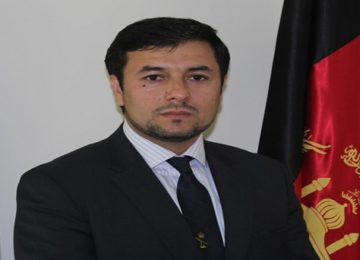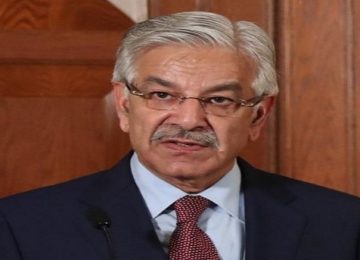SIGAR’s interim report on this topic, released in May 2022, was the first U.S. government account on how and why the Afghan National Defense and Security Forces (ANDSF) collapsed abruptly in August 2021. SIGAR’s new report updates that evaluation with compelling on-the-ground perspectives from witnesses to the ANDSF collapse. An “In Their Own Words” section provides quotes from over 40 interviewees, including former Afghan and U.S. officials who gave SIGAR perspectives about the ANDSF’s final two years. This section includes first-person accounts of the disintegration of the Afghan government and security forces as the Taliban closed in on Kabul, and the aftermath of the fall of the Ghani government.
SIGAR Findings and Commentary (Final Report):
— The last-minute wholesale restructuring of Afghanistan’s security institutions between March and June 2021, in particular, undermined ANDSF cohesion, morale, and ultimately, its ability to counter the Taliban offensive. In 2021, amid rapidly deteriorating security, President Ghani reshuffled most of his security officials, often replacing them with fellow ethnic Pashtuns, especially Ghilzai Pashtuns from eastern Afghanistan. These leadership changes were part of a broader pattern of politicization and ethnicization (in favor of Pashtuns) of the security sector in the final years of the Ghani administration.
(Page 23-24)
— Analyst Timor Sharan told SIGAR, “Districts collapsed not because of the army, but because of that restructuring that happened and the fact that none of [the replacement police chiefs] had connections” at the district level. He claimed that it was the police that did most of the fighting in the final 18 months, not the army. By undermining the morale and political legitimacy of the police, this restructuring directly contributed to the collapse in August 2021.
(Page 25-26)
— Ethnic competition between Pashtuns and non-Pashtuns (Tajiks, in particular)—enflamed by the Ghani-Abdullah rivalry—was likely the single biggest source of dysfunction within the ANDSF. But some former Afghan officials described other types of friction. One former MOD official described competition between the younger and older generation of officers, between the jihadis and the professional officers, and between ethnicities. All these issues distracted from the fight, he said.
(Page 26)
— General James Mattis, who served as head of Central Command from 2010 to 2013 and as Secretary of Defense from 2017 to 2018, told SIGAR, “The lack of political clarity on ends, ways, and means meant we were always wondering if we were still going to be here next year. Were we going to be funded next year? We weren’t sure whether to attack, retreat or go sideways.”
(Page 41)
— “In Their Own Words” (Appendix III) provides quotes from former ANDSF, Afghan and U.S. officials. It is broken down into six sections.
– The U.S.-Taliban Agreement and Withdrawal (Begins on Page 95)
– Withdrawing U.S. Contractors (Begins on Page 98)
– The ANDSF Disintegrates (Begins on Page 99)
– Exodus (Begins on Page 106)
– Evacuation from Kabul Airport (Begins on Page 107)
– Aftermath (Begins on Page 109)
— “Overnight…98 percent of U.S. air strikes had ceased…the Doha agreement’s psychological implication was so great that the average Afghan soldier felt this idea of abandonment…U.S. soldiers were confused [about] what to engage and what to not. On an hourly basis, the U.S. military had to coordinate with the Doha office of Ambassador Khalilzad and others from the State Department to get clarification on what they could do.”
– Gen. Sami Sadat, former Afghan Army corps commander
— “They [U.S. partners] said it was not right, but they have to follow orders. They would see the Taliban attacking our checkpoints. They would have videos of the Taliban doing it. But they would say we are not able to engage, because we have limitations. There was also so much concern about civilians, which gave the Taliban an advantage.”
– Former Afghan Army Gen. Habatullah Alizai
— “Before June…all the Black Hawks had maintenance contractors who could repair them in 24 hours. After June, Black Hawks had to be fixed in Dubai, which took weeks to months…My [special operations forces] were running out of supplies.”
– Gen. Alizai
— “Ghani was more interested in the tactical daily engagements on small minor issues rather than the big strategic issues that the country was facing…for God’s sake, we had provinces falling and he would still bloody hold National Procurement Council meetings for four hours. He would hold urban planning meetings while we had districts falling…”
– Former Deputy Minister of Foreign Affairs Hekmat Karzai
— “Nobody wanted to die for Ghani…die for people who were here to rob the country.”
– Former Interior Minister Gen. Masoud Andarabi
— The interviewee determined…they had 12 MD 530s ready to fly and 17 MD 530 pilots. He told his commander they were able to provide 360-degree protection of Kabul and asked for his orders… The commander said that the Taliban were not able to enter Kabul, and forbade anyone from leaving the area. The commander then left to speak to the media, stating that no one can enter Kabul, when in fact, the Taliban were already near the Palace.
– Former Afghan Air Force pilot, paraphrased interview
— “The Taliban are going after former ANDSF on a daily basis. They search their homes and if they cannot find the individual they will go after their family members…Since the collapse I have relocated four times…If they find out anything I will be executed.”
– Former Afghan military intelligence officer
— “…you’ve got guys who certainly do deserve to come to the U.S. who aren’t able to, and they’ve got a target on their back. The Taliban knows where they are and how to find them. It’s like we gave this guy a rope and noose around his neck and then kicked the chair out from under him.”
– U.S. Marine Corps infantry officer
Below are the interim report findings SIGAR previously sent in May 2022.
SIGAR Findings:
(Page numbers refer to those on the bottom right of the report pages.)
— SIGAR found that the single most important factor in the Afghan National Defense and Security Forces’ (ANDSF) collapse in August 2021 was the decision by two U.S. presidents to withdraw U.S. military and contractors from Afghanistan, while Afghan forces remained unable to sustain themselves.
(Page 6)
— One former U.S. commander in Afghanistan told SIGAR, “We built that army to run on contractor support. Without it, it can’t function. Game over…when the contractors pulled out, it was like we pulled all the sticks out of the Jenga pile and expected it to stay up.”
(Page 15)
— Former Afghan generals told SIGAR that the majority of the U.S.-made UH-60 Black Hawk helicopters were grounded shortly after U.S. contractors withdrew in the spring of 2021 [including those who performed maintenance on those helicopters]. “In a matter of months, 60 percent of the Black Hawks were grounded, with no Afghan or U.S. government plan to bring them back to life,” one Afghan general told SIGAR. As a result, Afghan soldiers in isolated bases were running out of ammunition or dying for lack of medical evacuation capabilities.
(Page 16)
— According to an senior Afghan official, it was not until President Biden’s April 14, 2021, announcement of the final troop and contractor withdrawal date that…President Ghani’s inner circle said they realized that the ANDSF had no supply and logistics capability. Although the Afghan government had operated in this way for nearly 20 years, their realization came only 4 months before its collapse.
(Page 31)
— The U.S.-Taliban agreement and subsequent withdrawal announcement degraded ANDSF morale. According to ANDSF officials, the U.S.-Taliban agreement was a catalyst for the collapse. A former Afghan commander told SIGAR that the agreement’s psychological impact was so great that the average Afghan soldier switched to survival mode and became susceptible to accepting other offers and deals. Another senior ANDSF official told us that after the Doha agreement was signed, Afghan soldiers knew they were not the winner.
(Page 6)
— After the signing of the U.S.-Taliban agreement, the U.S. military changed its level of military support to the ANDSF overnight, leaving the ANDSF without a critically important force multiplier: U.S. airstrikes. In 2019, the United States conducted 7,423 airstrikes, the most since at least 2009. In 2020, the U.S. conducted only 1,631 airstrikes, with almost half occurring in the two months prior to the U.S.-Taliban agreement.
(Page 12)
— Many factors affected the ANDSF’s determination to keep fighting: low salaries; poor logistics that led to food, water, and ammunition shortages; and corrupt commanders who colluded with contractors to skim off food and fuel contracts. But the root cause of the morale crisis may have been the lack of ANDSF buy-in with the Afghan central government.
(Page 10)
— One former Afghan government official told SIGAR that following the U.S.-Taliban agreement, President Ghani began to suspect that the United States wanted to remove him from power. That official and a former Afghan general believed Ghani feared a military coup. According to the general, Ghani became a “paranoid president…afraid of his own countrymen” and of U.S.-trained Afghan officers.
(Page 26)
— According to a former Afghan general, in the week before Kabul fell, President Ghani replaced the new generation of young U.S.-trained Afghan officers with an old guard of Communist generals in almost all of the army corps. Ghani, that general said, was “changing commanders constantly [to] bring back some of the old-school Communist generals who [he] saw as loyal to him, instead of these American-trained young officers who he [mostly] feared.”
(Page 26)
— According to a former Afghan Interior Minister, Afghan security officials briefed President Ghani about the impending U.S. withdrawal – five days before the April 14 announcement – but Afghanistan’s then-vice president told President Ghani that this was a U.S. plot, and the briefing was ignored.
(Page 21)
— The U.S.-Taliban agreement introduced tremendous uncertainty into the U.S.-Afghan relationship. Many of its provisions were not public, but are believed to be contained in secret written and verbal agreements between U.S. and Taliban envoys. Some U.S. analysts believe that one classified annex detailed the Taliban’s counterterrorism commitments, while a second classified annex detailed U.S. and Taliban restrictions on fighting. SIGAR was not able to obtain copies of these annexes, despite official requests made to the U.S. Department of Defense and the U.S. Department of State.
(Page 12)
— Afghan officials, largely removed from the negotiations, struggled most of all to understand what the United States had agreed to with the Taliban. According to Afghan government officials, the U.S. military never clearly communicated the specifics of its policy changes to the Ghani administration or ANDSF leadership. The Taliban’s operations and tactics, however, suggested that they may have had a better understanding of new U.S. levels of support the United States was willing to provide to the ANDSF following the signing of the U.S.-Taliban agreement.
(Page 13)
— According to a former Afghan general, in a broad sense, the U.S. military took on the role of a referee and watched the Afghan government and Taliban fight, something the general referred to as “a sick game.” According to that general, Afghan troops had not only lost U.S. support for offensive operations, they no longer knew if or when U.S. forces would come to their defense. U.S. inaction fueled mistrust among the ANDSF toward the United States and their own government.
(Page 13)
— Under the U.S.-Taliban agreement’s rules, U.S. aircraft could not target the Taliban groups that were waiting more than 500 meters away—the groups “beyond the contact” that would engage in the second, third, or fourth wave to defeat the last ANDSF units. A senior Afghan official said this was a loophole that the Taliban used in their targeting to their advantage.
(Page 13)
— While ANDSF forces were limited to a defensive posture, the Taliban took advantage of its freedom of movement to launch an undeclared offensive targeting vulnerable ANDSF supply lines. According to an Afghan general, an Afghan military assessment found that in 2020 the Taliban caused $600 million in damages to roads, electricity lines, schools, canals, and bridges in Helmand Province alone. “It was the same story all across the country,” the general told SIGAR.
(Page 37)
— The secrecy around U.S.-Taliban negotiations and the Doha agreement meant there was a lack of official information for the ANDSF. Taliban propaganda weaponized that vacuum against local commanders and elders by claiming the Taliban had a secret deal with the United States for certain districts or provinces to be surrendered to them. One former senior Afghan official told SIGAR that the Taliban used this tactic quite effectively, telling forces, “They’re going to give us this territory, why would you want to fight? We will forgive you…we will even give you 5,000 Afghanis for your travel expenses.” Having not been paid for months, the police would abandon their posts. Then, “the army panicked; they thought the police made a deal, and they’re going to be butchered. So, the army made a run for it too. That started a cascading effect.”
(Page 40)
— SIGAR found that no one country or agency had ownership of the ANDSF development mission. Instead, ownership existed within a NATO-led coalition and with temporary organizations. All of these entities were staffed with a constantly changing rotation of military and civilian advisors. The constant personnel turnover impeded continuity and institutional memory. The result was an uncoordinated approach that plagued the entire mission.
(See “What SIGAR Found”: Page ii (2nd Page))
— The Afghan government failed to develop a workable national security strategy that could assume responsibility for nationwide security following the withdrawal of U.S. forces. One of the main problems was the lack of nationally oriented leaders that were competent in managing and coordinating national security affairs.
(Page 30)
— According to a senior State Department official, U.S. government officials, including members of Congress with whom President Ghani communicated through unofficial channels, reinforced President Ghani’s misperceptions about the U.S. withdrawal. The apparent disconnect between unofficial channels of support and public pronouncements gave President Ghani the impression that the U.S. government was not altogether on the same page on full withdrawal, and that the withdrawal announcement was intended to shape his behavior, as opposed to being official U.S. policy.
(Page 9)
— The length of the U.S. commitment was disconnected from a realistic understanding of the time required to build a self-sustaining security sector—a process that took decades to achieve in South Korea. Constantly changing and politically driven milestones for U.S. engagement undermined the ability to set realistic goals for building a capable and self-sustaining military and police force. Further, many of the up-and-coming ANDSF generals had only a decade of experience; most general officers in the U.S. military have twice as much. Adapting a decades-long process to an unrealistically short timeline was reminiscent of the U.S. experiences in Vietnam.
(Page ii; see Appendix IV for more details)
CONCLUSION:
— The U.S. approach to reconstructing the ANDSF lacked the political will to dedicate the time and resources necessary to reconstruct an entire security sector in a war-torn and impoverished country. As a result, the U.S. created an ANDSF that could not operate independently, milestones for ANDSF capability development were unrealistic, and the eventual collapse of the ANDSF’s was predictable. After 20 years of training and development, the ANDSF never became a cohesive, substantive force capable of operating on its own. The U.S. and Afghan governments share in the blame. Neither side appeared to have the political commitment to doing what it would take to address the challenges, including devoting the time and resources necessary to develop a professional ANDSF, a multi-generational process. In essence, U.S. and Afghan efforts to cultivate an effective and sustainable security assistance sector were likely to fail from the beginning. The February 2020 decision to commit to a rapid U.S. military withdrawal sealed the ANDSF’s fate.
(See full Conclusion, Page 78)
Office of the Special Inspector General for Afghanistan Reconstruction
Full Report: https://www.sigar.mil/pdf/evaluations/SIGAR-23-16-IP.pdf








